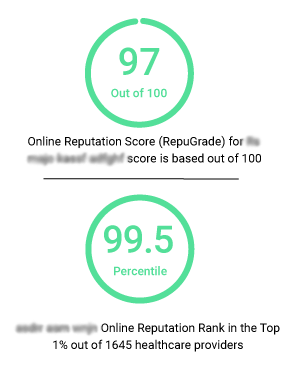How to Improve Patient Satisfaction Score to Grow Your Practice

A patient satisfaction score measures how closely a patient’s healthcare experience matches his or her expectations regarding the care quality. While all patients expect quality care from their providers or doctors, their overall satisfaction often depends on much more than just the results. They also assess their satisfaction based on factors like communication, interactions with both medical and non-medical staff, your clinic or practice’s environment, and even the technology used.
Here’s a look at why patient satisfaction score matters and how you can improve it to grow your healthcare practice.
Why Patient Satisfaction Matters for Your Healthcare Practice in a Digital World
In today’s digital world, patient satisfaction impacts your practice’s success in multiple ways. When patients are highly satisfied, they are more likely to stay with your practice and refer your practice to others.
Your online reputation is also at stake here, which is why you should aim to have the highest possible patient satisfaction rate. If your patients are happy or unhappy about issues like time wait times or their encounter with a doctor or staff at your practice, they won’t keep it to themselves. Most are keen to share their experiences on platforms like Google, Yelp, and Healthgrades. You want to have a great online reputation because about 70% of prospective patients use online reviews in selecting their provider.
As you get more positive feedback about key components of your medical practice, you can improve your image among existing and prospective patients. It’s a much more cost-effective way to promote and grow your practice.
Improving Patient Satisfaction Scores to Accelerate Your Practice’s Growth
To effectively compete with other medical practices online, you’ll want to take practical measures to boost your patient satisfaction levels. Learn about your patients’ expectations and determining the healthcare qualities they value the most. Start by assessing the quality of care and healthcare experiences from your patients’ perspectives.
When you know what your patients want, you can take appropriate steps to improve care quality and overall experiences. Here are some realistic ways to increase your patient satisfaction rates:
1. Staff Training
Train your employees to prioritize high-quality care and focus on delivering positive patient experiences. From the front desk and customer care to your medical team, all personnel should make patient-centric care a priority. While your doctors may be doing excellent work, consistently poor responsive experiences with front desk staff or call center representatives can hurt the overall satisfaction score. Training and holding your entire team responsible for the overall patient experience can help address this problem.
2. Patient Education
The more informed a patient is about their diagnosis and treatment options, the higher their satisfaction level will be. Educating your patients can help improve their compliance with treatment, enhancing outcomes. However, patient education shouldn’t be a one-off event at the doctor’s office. You can regularly use email marketing to distribute educational content targeted to individual patients based on their unique needs.
3. Nursing Empowerment
Nurses spend more time with their patients than doctors, which is why they play a vital role in promoting patients’ satisfaction levels. Empowering these “mission-critical” professionals means giving them the authority and capacity to make independent decisions that bring positive patient experiences and outcomes. Instead of always imposing solutions to boost patient care and satisfaction, let your more experienced nurses independently collaborate and find their own way to improve performance
4. Scheduling Flexibility
Have a system in place to ensure your patients are seen in a timely manner. Since long waiting times are partly responsible for poor patient satisfaction rates, you’ll need to improve your practice’s efficiency to enable patients to be seen by doctors as quickly as possible. Consider providing a scheduling system with features like self-scheduling, waiting lists, or even automated patient reminders.
5. Enhanced Doctor-Patient Communication
When patients cannot communicate with their providers or doctors between appointments, they’re less satisfied with their overall healthcare experiences. You can address this issue by offering a digital platform (mobile is ideal) to enable two-way communication between doctors and their patients. This can help build long-term patient relationships, facilitate appointment scheduling, and boost treatment outcomes.
How to Track Your Practice’s Patient Satisfaction Score
According to a recent study, about 52% of patients who leave negative online reviews about a provider have not been approached to address their pain points. The same survey showed that the patient satisfaction score increases appreciably when the mentioned medical practice addresses negative online feedback.
With our online reputation platform, you can extract in-depth patient satisfaction insights, empowering you to make the necessary patient experience improvements. Also, our platform helps you monitor online reviews for your practice and conduct post-visit surveys to know how each patient feels about your healthcare service delivery.
You can even carry out AI-driven, granular sentiment analytics, which enables you to assess the level of satisfaction associated with individual staff, such as caregivers and departments across your healthcare organization or practice.
Have you adopted telemedicine (TM) yet? In a recent study, this technology yielded a 95% or higher patient satisfaction rate compared with in-person encounters. We can help you measure the levels of patient contentment associated with any virtual healthcare experiences you’re offering.
Our platform covers the entire patient journey, tracking sentiment at each touchpoint. It gives you a detailed and complete picture of the overall healthcare experience. Enabling you to see where satisfaction levels are going up or down to make appropriate improvements, protect your reputation, and attract more patients.
Comments are closed


